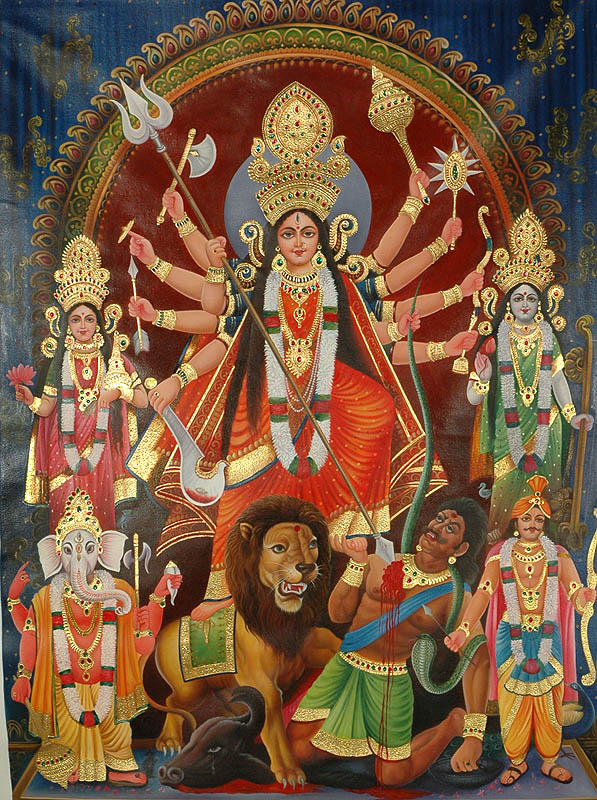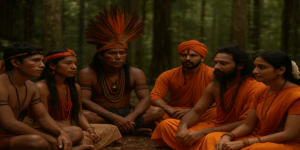In these last decades, the world has been changing. The phenomenon called “Hindu Awakening” has created a growing favorable interest towards Hinduism not only in India, but at global level. Simultaneously, we have seen that in Western countries there has been a considerable development of the neo-pagan movements and the resurgence of ancient native religions and cultures – all of which are fundamentally compatible with Hinduism, the last surviving bulwark of ancient pre-abrahamic cultures.
 The monolith of the abrahamic ideologies is cracking, and so is the biased academic approach that was aimed at dismissing the ancient pagan cultures as primitive and ignorant superstitions or childish fables.
The monolith of the abrahamic ideologies is cracking, and so is the biased academic approach that was aimed at dismissing the ancient pagan cultures as primitive and ignorant superstitions or childish fables.
People from all walks of life and backgrounds are eager to get direct access to the ancient texts and original traditions, to find answers to their individual and collective questions, and better solutions to the serious problems we are all facing.
A paradigm shift is actually happening. One of the central concepts in this new consciousness is the need to overcome artificial damaging divisions and to unite all the good people in taking action for the benefit of the entire planet. The old discriminations and prejudice, fostering fear and hatred, need to be replaced by open-mindedness and a sincere spirit of understanding and cooperation.
 Hinduism does not look out of place at the forefront of this movement, if we consider that along history many great intellectuals, philosophers and seekers from all corners of the world traveled to India to find inspiration and knowledge, and praised the Vedic texts as amazingly deep and scientifically accurate, both on the level of physics and on the level of metaphysics.
Hinduism does not look out of place at the forefront of this movement, if we consider that along history many great intellectuals, philosophers and seekers from all corners of the world traveled to India to find inspiration and knowledge, and praised the Vedic texts as amazingly deep and scientifically accurate, both on the level of physics and on the level of metaphysics.
Still today, Hinduism has much to offer to mankind, provided it returns to its roots, removing the noxious weeds of avidya and adharma that have been sown by enemies and have grown into a confused mess of misconceptions even in the minds of “traditional Hindus”.
This clean up work is not against the inherently inclusive and tolerant nature of Hinduism, exemplified by the Vedic hymn that teaches
aa no bhadra kritavo yantu visvatah,
“let all good things come to us from all directions” (Rig Veda 1.1.89, Sukla Yajur Veda 27.1)
and by the quote ekam sat vipraha, bahudha vadanti,
“Truth is one, but the wise call it by various names” (Rig Veda 1.164.46).
 We must be extremely careful here to clearly understand the basics, because ignorantly mistaking abhadra (bad things) for bhadra (good things), asatya (deceit) for satya (truth) and adharma (evil) for dharma (good) is a fundamental disaster that poisons the entire system.
We must be extremely careful here to clearly understand the basics, because ignorantly mistaking abhadra (bad things) for bhadra (good things), asatya (deceit) for satya (truth) and adharma (evil) for dharma (good) is a fundamental disaster that poisons the entire system.
Bhagavad gita (18.29-32) details the three approaches to understanding religion, based respectively on goodness (sattva), selfishness (rajas) and stupidity (tamas), according to the mentality of people.
The good (sattvic) religious approach is based on intelligence and clearly makes a distinction between ethical and unethical, between the path of evolution and liberation and the path of conditioning and suffering. The selfish (rajasic) religious approach does not give much importance to the difference between dharma and adharma, and makes choices based on selfish interest (individual or collective) and sectarianism.
The idiotic (tamasic) religious approach regularly gets things upside down, mistaking dharma for adharma and the other way around, protecting the bad people and persecuting good people.
The key to solve our problem is knowledge (jnana, or vidya) that helps us to overcome the ignorance (tamas) and see things as they are, and not “upside down”. The ignorance of illusory perception is caused by the artificial superimposition (adhyasa) of two different concepts, as for example a rope and a snake: this makes us see a rope as a snake, and the other way around – with the result of being bitten and poisoned.
 In brief, we can say that Hinduism, or better Sanatana Dharma (“the eternal/ universal principles of ethics”) should accept, embrace and assimilate only those religious approaches that are compatible with such principles.
In brief, we can say that Hinduism, or better Sanatana Dharma (“the eternal/ universal principles of ethics”) should accept, embrace and assimilate only those religious approaches that are compatible with such principles.
When we say, sarva dharma samo bhavah (“all dharmas are based on the same sentiments”) we should not allow adharma to line up in the picture together with the various dharmic approaches, because that is the root of the disaster. The variety of dharmas only applies to the many specific paths that afford proper engagement and a gradual system of realization for the different levels of personal evolution.
So the dharma or religious engagement for a brahmana (an intellectual and teacher) is different from the religious engagement for a kshatriya (administrator, warrior and policeman), and from the religious engagement for a vaisya (entrepreneur) and the religious engagement for a sudra (unskilled laborer). It also applies to the variety of worship systems offered by the tantric knowledge that gives slightly different specifications for the individuals who have chosen a particular ista deva – vaishnavas, shaivas, shaktas, etc. This means that the worship of Vishnu includes slightly different parameters from the worship of Shakti, etc.
But dharma is only what is based on the universal and eternal principles of dharma: there is no such a thing as “criminal dharma”, or “adharmic dharma” – an oxymoron if there has ever been one.
The word DHARMA does not correspond precisely to the word “religion”. It is much more than that.
 Dharma comes from the Sanskrit root dhar, meaning “to support”, and indicates that subtle natural law of cooperation and mutual support that binds together all realities in the universe for the proper functioning of everything. The basic principles of Dharma are sincerity or truthfulness, compassion, cleanliness and purity, self-discipline, the cultivation of knowledge and consciousness, personal evolution, and the sense of duty and responsibility.
Dharma comes from the Sanskrit root dhar, meaning “to support”, and indicates that subtle natural law of cooperation and mutual support that binds together all realities in the universe for the proper functioning of everything. The basic principles of Dharma are sincerity or truthfulness, compassion, cleanliness and purity, self-discipline, the cultivation of knowledge and consciousness, personal evolution, and the sense of duty and responsibility.
These concepts are naturally embedded in the conscience of all human beings, and also govern the natural laws of the universe including the functions of the elements and the orbits of the planets.
When a “religion” preaches and/ or practices adharma, the opposite of these basic principles of dharma, it cannot be called dharma, and it cannot be accepted as a legitimate justification for criminal actions.
Because normal human intelligence and conscience can easily and spontaneously recognize the difference between dharma and adharma, false “religions” need to create a number of oppressive and distorting mechanisms to confuse the minds of people and reinforce the tendency to ignorance (tamas) in society, starting from the construction of a deceitful system of “knowledge” that ensures the perpetuation of adharma in the name of adharma.
Some of these adharmic concepts have been treacherously introduced in Indian society by the colonial regime under the guise of modern education, through the biased and untruthful presentation of the original Vedic concepts in denigratory definitions in English language – definitions that nobody in abrahamic ideologies (Christians, Muslims or Jews) would ever apply to their own tradition, rather choosing dignified expressions such as “hagiography”, “sacred image”, and so on.
Many innocent or uninformed Indian Hindus still use such denigratory definitions without realizing their real import, or even the actual meaning of the original Vedic concepts, while many western students of Hinduism are now happy to use the appropriate Sanskrit definitions as they were originally established in the Vedic scriptures – for example, dharma, vigraha, lila, puja, bhakta, mantra, deva, sannyasi, sadhu, brahmachari, brahmana, guru, and so on.
A quick perusal of a good dictionary (Webster’s, for example), will make us aware that:
IDOL means “false god, pretender, impostor, a form of appearance visible but substance, a fallacy, a false conception”.
IDOLATER means “a worshiper of idols, a person that admires intensely and often blindly one that is not usually an object of worship”.
IDOLATRY means, “the worship of a physical object as a god, immoderate attachment or devotion to something”.
MYTH means, “a usually traditional story of ostensibly historical events that serves to unfold the world view of a people or explain a practice, belief, or natural phenomenon”, but also “an unfounded or false notion, a person or thing having only an imaginary or unverifiable existence”.
MYTHOLOGY means, “an allegorical narrative, a body of myths, the myths dealing with the gods, demigods, and legendary heroes of a particular people”.
LEGEND means, “a story coming down from the past, one popularly regarded as historical although not verifiable”.
CULT (“a religion regarded as unorthodox or spurious”, generally used to refer to bogus groups such as the famous Sarin terrorist cult of Japan etc).
INCANTATION (“a use of spells or verbal charm spoken or sung as a part of a ritual of magic”, where “magic” is considered a bad thing if not mere illusionism).
Note: Interested readers can peruse the published works of Mataji Parama Karuna Devi at their local Amazon supplier.
http://www.amazon.com/-/e/B00CGRQ8GA
































